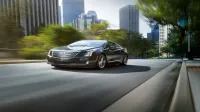How Cadillac improved power output in 2016 ELR by 25 percent

Let’s refresh our memories with the numeric details. The 2016 car is 1.5 seconds quicker to 60 miles per hour than the 2014 model (there was no 2015), down to 6.4 seconds. The 2014 put out 295 pound-feet of torque. For 2016, it will be 373 lb-ft. The specific breakdown of the various components in the powertrain has not been disclosed, but from what we can tell, the two electric motors and the 1.4-liter inline-four engine in the new ELR are not that much different than those in the old one.
Sam Abuelsamid, senior research analyst at Navigant Research (and former writer here at Autoblog) said that any of the unspecified upgrades would be difficult to tell on a part-by-part basis, but the overall effect will be noticeable. “The changes to the ELR as I understand them are analogous to getting more performance out of a 1965 Mustang with the entry version of the 289 cubic-inch V8. You can replace the carburetor with a larger version that enables more air and fuel to flow into the engine, thus producing more power. The basic engine hasn’t changed, but power capability is being unleashed by feeding it more.”
“Cadillac has changed components in the power electronics to enable more current flow into the motor and thus produce more torque. When you do this in the Mustang, you probably need to replace the rear axle gears and use a beefier clutch to transmit the power to the wheels. Similarly, the ELR probably has some upgraded clutches, bearings, and gears to withstand the increased total output.”
Cadillac spokesperson David Caldwell told AutoblogGreen in an email that the new ELR does indeed have more than just new lines of code. “One could not ‘reflash’ a previous ELR to get the performance of a 2016,” Caldwell said. “If one only changed software you would not get the performance upgrade fully, as the 2016 creates higher current, more power. So these have been upgraded physically – hardware. And yes of course there is also new software on top.” Here are some official specs of the electric drive of the 2016 ELR:
|
Type: |
electric, two-wheel, front-drive |
|
Motors (two): |
160 kW in tour (EV) mode; 174 kW Sport mode max drive power; 55 kW generating power |
|
Transaxle: |
electric drive system |
|
Power (kW): |
174/233 (total system power) |
|
Torque: (lb-ft / Nm): |
373/506 |
Caldwell also said that the 2016 ELR has an expanded Sport Mode. Previously, there was a sort of “dual motor” condition where the engine could couple to the gearset through the electric motor to have both motors operating together. This setup would be used for high-load operations during low state-of-charge conditions only.
“Now for 2016, in Sport Mode, we can have the ‘dual’ power thing, and its use is expanded,” Caldwell said. “This is a revision – but only in certain conditions, not just by selecting Sport Mode. In Sport Mode, the system will only go to the ‘dual’ operation when conditions merit (such as aggressive throttle application, etc.). If acceleration or throttle is moderate or mild in Sport Mode, then power is delivered ‘normally.’ And even when operating in the standard power condition, it’s more powerful than previously.”
Abuelsamid said that from what he understands, the new Sport Mode gives the new ELR the capability to use power that was previously only available at higher speeds. “Now you can have both motors and the engine contributing to the torque at the wheels at low speeds,” he said. “The primary reason is to get more performance. One of the complaints that customers have had of the ELR since the launch is that for $75,000, performance was so-so. You want a little bit more. You start comparing it with the Model S, which is insanely quick, it was a bit of a laggard. It’s still not as quick as the Tesla, but for the price point, it is more respectable.”
There’s another nice side effect as well, Abuelsamid said. “[GM] may have improved the overall efficiency by doing that, having more of a traditional parallel hybrid in there. Which goes back to what Toyota said back in 2007, when Toyota said that if GM builds the Volt that way, it won’t be as efficient. And they were right.”
Related Video:
#fivemin-widget-blogsmith-image-701008{display:none;} .cke_show_borders #fivemin-widget-blogsmith-image-701008, #postcontentcontainer #fivemin-widget-blogsmith-image-701008{width:100%;display:block;}




